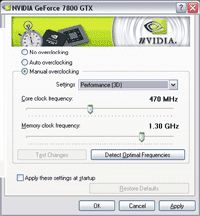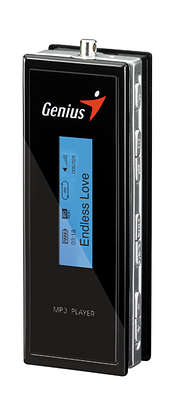 |
||
|
||
| ||
Antec P180 — a new approach to desktop cooling Intel to announce Pentium D for servers On the clock rates of GeForce 7800 GTX GPU Genius to ship its first MP3 players in Q4 2005 IBM announces new PowerPC processors Antec P180 — a new approach to desktop cooling Antec introduced a new solution and a new approach to organizing airflow inside PC enclosures. Though based on the ATX standard, the CPU and graphics card zone has a dedicated "heat pipe", which is not obstructed by PSU located below in its own heat pipe.  3 x 120mm fans create strong airflow. At that 2 are located in the CPU area, while the 3rd cools HDD tray and PSU like it was a server. Besides, the 4th 120mm fan is available as a front-panel option as well as a 80mm graphics card cooler. The enclosure is made of 0.8mm steel. Side panels are made of two layers of aluminium with a layer of plastic in-between for better sound damping.  The front panel offers USB, FireWire and audio interfaces, 4 x 5.25" bays and 1 x 3.5" bay. Inside, there are 6 x 3.5" bays for hard drives. The fans feature dust filters that can be detached to clean. Sized 541x506x206mm, the enclosure weighs 14kg. Orders are accepted, the price is about $170 without PSU. Source: Antec
Intel to announce Pentium D for servers Intel is expected to announce this week that its Pentium D can now be sold with a new chipset, the Intel E7230, that has features best suited for entry-level servers. Code-named Mukilteo, the chipset is the follow-on to Intel´s Copper River, which is commonly used in workstations. The E7230 comes with the ability to handle 64-bit operating systems such as the Windows XP x64 Edition from Microsoft, advanced dynamic computer memory, faster data transfers via PCI Express and software that emulates storage through the redundant array of independent disks (more commonly known as RAID). The chipsets will sell for $36 apiece when PC makers buy more than 1,000 of them. Pentium D chips retail for $530, $316, $241 in speeds of 3.2GHz, 3GHz and 2.8GHz respectively. Server manufacturers such as Dell and Hewlett-Packard are expected to sell the new Pentium D servers to run simple network server applications such as a Web server or a small database. Previous Next Intel has outfitted its desktop warrior Pentium for servers before. Some businesses report having Pentium II and Pentium III machines, but these are still single-core processors. A dual-core chip means there are two processor cores in one piece of silicon. The effect is a computer brain that can handle multiple operations at once. Intel, IBM and Advanced Micro Devices are all transitioning their product lines from single-core chips to dual-core ones. Intel has 15 dual-core projects under way. However, the company has only two dual-core processors on the market: its Pentium Extreme Edition and the Pentium D. Intel´s traditional server processors are not expected to make a transition to dual core for at least a few more months. Dual-core Itanium server chips are not due to arrive until later this year, and Intel´s dual-core Xeon processors are not expected until the first quarter of 2006, company executives have said. Source: CNET News
On the clock rates of GeForce 7800 GTX GPU Straight away, here´s a screenshot of drivers control panel with a nominal 3D clock rate of Gainward´s G70-based card:  As you can see, it´s all correct and the clock rates are 470/1300 MHz, as promised. However when we tested the reference card we noticed that RivaTuner tool (by A. Nikolaychuk aka Unwinder) indicated some other clock rate that was about 40MHz higher than nominal (430MHz reference + 40MHz = 470MHz). The matter is that at that time Rivatuner determined the maximal clocking value. Together with the developer of this utility we started to investigate the matter testing the card with ±5MHz steps and dumping register reports. We found out there were THREE clock rates at once! Now there´s information in the Web that NVIDIA privately mentions more clock rate values as the GPU itself consists of multiple unit, each of which is able to work at its own clock rate. This makes it obscure which clock rate should be considered primary and be placed on package boxes, etc. It would be logical to consider rasterizer and pixel pipeline clock rate primary, but now it turns out this unit is also divisible, as there´s at least ROP and Shader unit. In other words, this is still not clear, but since both of these sub-units work at the same clock rate, it can be taken as the base. Exactly this value is declared 430MHz of the reference card and 470MHz of this Gainward´s product. But then what was that 40MHz higher clock rate? Well, it´s geometry unit clock rate. And since it consists of vertex pipelines, we can say they are operating at 470MHz. Right after the G70 announcement ASUS informed that its card will work at this very rate. We haven´t examined this product yet, but can assume that company´s marketing team decided to name 470MHz of the geometry unit as primary. Thus we guess the SmartDoctor utility will indicate this clock rate like the RivaTuner 15.6. Again, these are just our assumptions and, perhaps, Asus, like Gainward, will change the base clock rate as well. So, let´s describe the primary (base) clock rate again. Of all said above we see that there are THREE units with possibly different clock rates: ROP, Shader Unit and Vertex Unit. Alexey Nikolaychuk has already differentiaed these in his new Rivatuner 15.7 that is to be released soon:  Also note however that in 2D mode all three units work at the same 275MHz. When 3D is enabled (you will see it in a video included into our next article), we can see the clock raise to different extents: the geometry unit clocked strictly to 470MHz of BIOS + 40MHz = 510MHz, while other two began working at 459MHz, not the 470MHz. The investigation indicated that ROP and Shader Unit clock rates are changed by the drivers synchronously with the geometry unit and it´s impossible at the moment to change them separately. Second, the increment of this is 27MHz! The card features 27MHz quartz clock and the drivers select the clock rate by multipliers. In our case its like this: 27MHz * 16 / 1 = 432 MHz
These are the very 432MHz (declated as 430MHz) of the reference card. And the further overclocking can give us only 459MHz, 486MHz, 513MHz, etc. Thus 470MHz is not possible for these two GPU units today! Again, this is drivers´ feature, therefore the situation might change with the newer versions. So, the drivers just selects clock rate which is the closest to the value set in its control panel. 470MHz is closer to 459 than to 486, that´s why we can see 459MHz indicated by the monitoring utility. So the real clock rates are 459/1300 MHz and 510MHz of the geometry unit. As you remember, since GeForce FX series, the high-end card can work in THREE modes: 3D High Power, 3D Low Power and 2D. The average power mode haven´t been presented in NVIDIA´s drivers, so it was unaccessible unless you used RivaTuner. These three modes are still present today. The 3D Low Power is enabled after you quit a 3D application.  As we can see, the transition to 275MHz of the 2D mode is not performed at once, but after 3-5 seconds of 418MHz (3D Low Power) mode. Note that the drivers use other multipliers for this clock rate: 27MHz * 31 / 2 = 418.5 ÌÃö
This exactly indicates that potentially the drivers can use different multipliers, so the aforementioned 27MHz increments might change in the future. To draw a bottom line, we have found out that there are 3 GPU units with potentially different clock rate, but the drivers keep them in batch with the only exclusion of flexible geometry unit multipliers that allow us to change geometry unit clock rate within the range of the half of the fixed ROP/Shader Units increment (27MHz), given the ROP/Shader Units clock rate doesn´t change. We´ve also found out that Vertex Unit clock rate is strictly higher by the same 40MHz set by BIOS. Our work is not finished yet, as according NVIDIA, there are more then 3 units with different clock rates in the new GPU. But this actually means one thing: from now on you can´t say "this GPU works at this clock rate", or at least you should also mention which clock rate this is: ROP or the Shader Unit, since they affect performance most.
Genius to ship its first MP3 players in Q4 2005 KYE Systems, the owner of the Genius brand, informed about expanding its presence on the home entertainment market. In Q4 2005 the company is going to ship two variants of Genius MP3-DJ players. The series will further be expanded with new hard-drive and flash based novelties.  The Genius MP3-DJ is a compact player with an FM tuner designed in Genius´s traditional way.  It supports MP3, WMA and WAV and can store up to 30 radio stations of 87.5-108 MHz range. Of course, it can be used as mere data storage. Genius MP3-DJ features 132x32 blue-backlit display and supports 8 languages, including English, French, Italian, Spanish, Portuguese, Danish, Dutch and Russian. The SNR value of the player is 90dB in 20Hz — 20kHz range. The built-in equalizer features 5 presets (Pop, Jazz, Classic, Rock and Normal). The novelty connects to PC via USB2.0 interface and powers from AAA batteries (up to 10 hours per full charge). A rather interesting feature for such type of devices is the 5-step power-saving mode.
IBM announces new PowerPC processors At Power Everywhere in Tokyo IBM announced two new G5 processor lines. The PowerPC 970MP is a dual-core version of the PowerPC 970FX, which is commonly found in Macintosh computers running G5 processors. IBM also said it will release a low-power version of the PowerPC 970FX. What´s novel about the PowerPC 970MP´s design is that each of the two 64-bit cores has its own dedicated 1MB of L2 cache. That means that either side of the chip can be powered down to a state IBM calls "doze" while the other core continues to work. The technique helps save power and extends the life of the computer, IBM said. The chip will be available in speeds ranging from 1.4GHz to 2.5GHz. The low-power version of its PowerPC 970FX is meant for use in printers and digital video recorders. The processor is designed to run at speeds of up to 2.7GHz, yet operate at less than 20 watts. IBM said it plans to offer the new processors in a variety of ways: in clusters of servers such as its Blue Gene/L super computer, for example, as well as in high-performance storage devices, single-board computers and networking products. Both processor announcements are tied to IBM´s promotion of its Power Architecture technology, which the company has been trying to position as an alternative to x86-based systems made by Intel and Advanced Micro Devices. With that in mind, IBM also announced the launch of its OpenPower Project, an online forum for IT professionals and developers within the Linux community that will get access to tools and other reference software from IBM. Developers and enthusiasts that sign up will be able to test their software on Power5-based OpenPower servers, IBM said. Source: CNET News
Write a comment below. No registration needed!
|
Platform · Video · Multimedia · Mobile · Other || About us & Privacy policy · Twitter · Facebook Copyright © Byrds Research & Publishing, Ltd., 1997–2011. All rights reserved. |